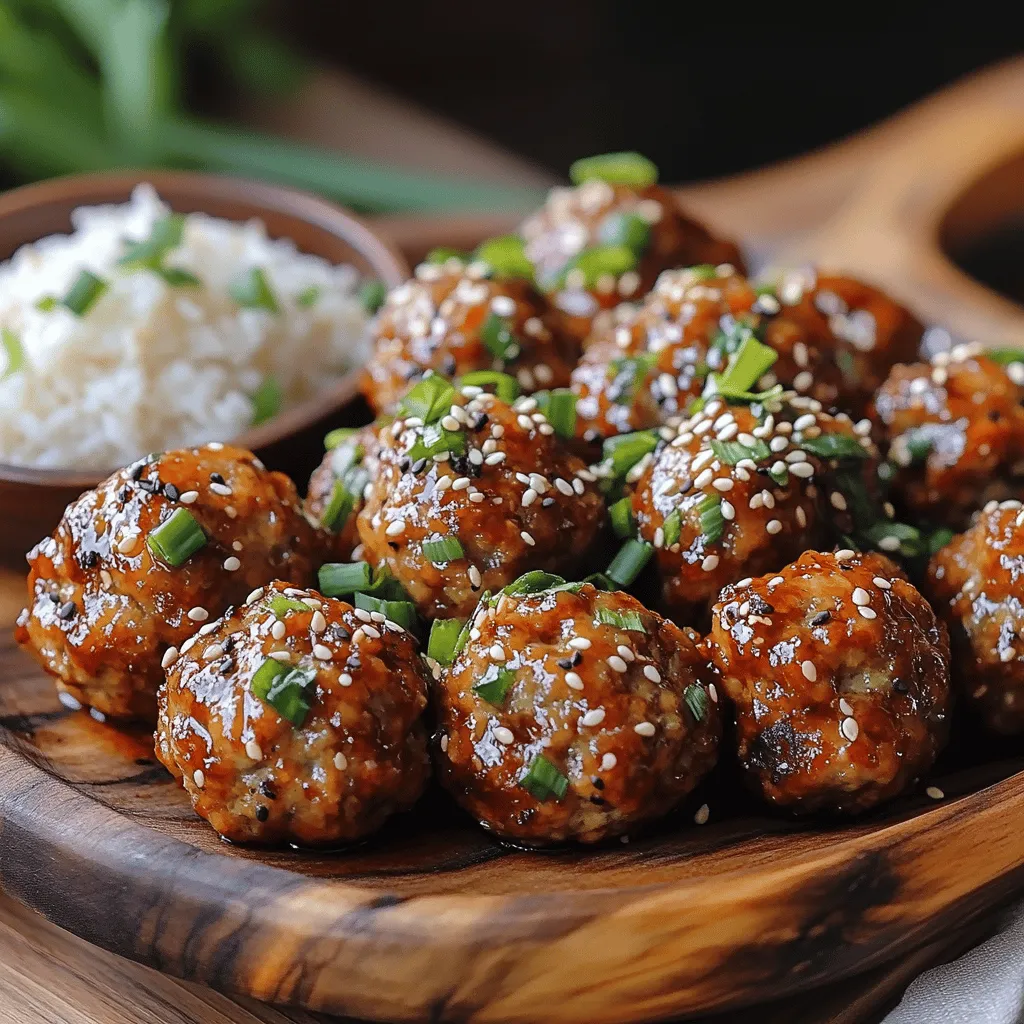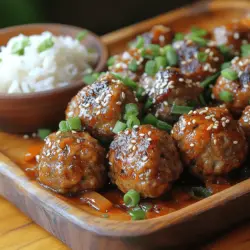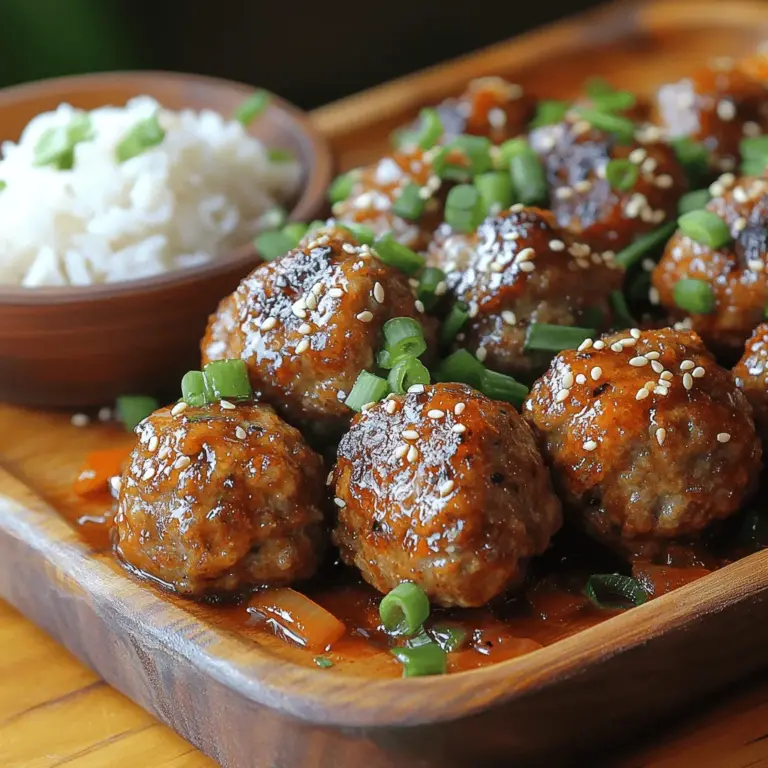Introduction to Korean BBQ Meatballs
Korean cuisine has taken the culinary world by storm, captivating taste buds with its vibrant flavors, tantalizing textures, and bold combinations. From the smoky aromas of grilled bulgogi to the spicy kick of kimchi, the essence of Korean food is a celebration of harmony and balance. Among its many offerings, Korean BBQ meatballs have emerged as a popular fusion dish that marries traditional Korean flavors with a universally loved comfort food—meatballs. This unique dish not only showcases the rich culinary heritage of Korea but also offers a modern twist that appeals to diverse palates.
Korean BBQ meatballs are a delightful combination of ground meat, aromatic ingredients, and distinctive Korean seasonings. The result is a juicy, tender meatball bursting with flavor, making it an ideal appetizer or main dish. This recipe allows you to explore the delicious world of Korean BBQ right in your kitchen, bringing the essence of Korean street food to your dining table.
In this article, we will delve into the unique ingredients that set these meatballs apart, the flavors that define them, and a step-by-step guide to crafting the perfect Korean BBQ meatballs. Whether you are a seasoned chef or a cooking novice, you will find that creating this dish is not only easy but also incredibly rewarding.
Understanding the Ingredients
Ground Meat Choices
When it comes to crafting the perfect meatball, the choice of ground meat plays a crucial role in the flavor and texture of the final dish. For Korean BBQ meatballs, a combination of ground beef and ground pork is often used, striking a perfect balance between richness and tenderness.
– Ground Beef: This meat brings a robust flavor and a satisfying chew to the meatballs. The fat content in ground beef adds moisture, ensuring that the meatballs remain juicy during cooking.
– Ground Pork: On the other hand, ground pork adds a subtle sweetness and enhances the overall flavor profile. Its higher fat content compared to ground beef contributes to a tender and moist texture, which is essential for achieving the ideal meatball consistency.
Choosing the right ratio of beef to pork can elevate your meatballs. A blend of 70% ground beef and 30% ground pork is a popular choice, allowing each meat’s unique characteristics to shine through without overshadowing the other.
Role of Breadcrumbs
Breadcrumbs are a crucial ingredient in meatball recipes, and their role cannot be understated. They serve several purposes, including improving the consistency and moisture retention of the meatballs.
– Moisture Retention: When mixed with ground meat, breadcrumbs absorb moisture and fats released during cooking. This helps to keep the meatballs tender and juicy, preventing them from drying out.
– Structural Integrity: Breadcrumbs also act as a binding agent, helping the meatballs hold their shape as they cook. This is especially important for Korean BBQ meatballs, which need to maintain their form when grilled or baked.
For this recipe, using plain or panko breadcrumbs adds an airy texture to the meatballs, enhancing their overall bite and mouthfeel.
Aromatics: Green Onions, Garlic, and Ginger
Aromatics are the backbone of any flavorful dish, and in the case of Korean BBQ meatballs, green onions, garlic, and ginger are essential for providing depth and authenticity.
– Green Onions: Also known as scallions, green onions add a mild onion flavor and a fresh, crisp element to the meatball mixture. They also impart a vibrant green color, making the dish visually appealing.
– Garlic: The pungent and aromatic qualities of garlic elevate the flavor profile of the meatballs. When finely minced, garlic infuses the meat mixture with a warm, savory essence that is quintessential to Korean cuisine.
– Ginger: Fresh ginger adds a subtle sweetness and a hint of spiciness, enhancing the overall flavor complexity. Its bright and zesty notes help cut through the richness of the meat, creating a well-rounded taste experience.
Together, these aromatics create a fragrant blend that complements the rich flavors of the meat and the umami notes from the seasonings.
Soy Sauce and Sesame Oil
Soy sauce and sesame oil are staples in Korean cooking, and they play a vital role in seasoning the meatball mixture.
– Soy Sauce: This fermented condiment adds a savory, umami flavor that enhances the overall taste of the meatballs. It also contributes a rich, dark color, making the meatballs visually appetizing. Low-sodium soy sauce is a great option to control the saltiness of the dish without sacrificing flavor.
– Sesame Oil: Known for its nutty aroma and flavor, sesame oil is a key ingredient that brings an unmistakable essence of Korean cuisine to the dish. Using toasted sesame oil can impart even more depth and richness to the meatballs, making them irresistible.
Gochujang: The Heart of Korean Flavor
No discussion of Korean BBQ meatballs would be complete without mentioning gochujang, a fermented chili paste that is the heart of Korean flavor.
– Spiciness: Gochujang strikes a unique balance between heat and sweetness, making it a versatile ingredient in many Korean dishes. The level of spiciness can vary, so it’s important to adjust the amount according to your preference.
– Flavor Complexity: Beyond its heat, gochujang adds a depth of flavor that distinguishes Korean BBQ from other cuisines. Its fermented nature contributes a savory richness that enhances the overall taste of the meatballs.
Incorporating gochujang into the meatball mixture is crucial for achieving the authentic flavor profile that defines Korean BBQ.
Sweetness and Balance with Sugar and Honey
Achieving the perfect balance of flavors is essential in any recipe, and Korean BBQ meatballs are no exception. To complement the savory and spicy notes from the other ingredients, a touch of sweetness is added through sugar or honey.
– Sugar: A small amount of brown sugar can enhance the caramelization during cooking, giving the meatballs a beautiful glaze and a delightful sweetness that balances the heat from gochujang.
– Honey: For those looking for a natural sweetener, honey can be a fantastic alternative. Its floral notes add complexity to the flavor profile while also helping to create a sticky, glossy finish on the meatballs.
By carefully balancing these sweet elements with the savory and spicy ingredients, you create a harmonious flavor experience that is characteristic of Korean cuisine.
Step-by-Step Guide to Making Korean BBQ Meatballs
Preparing the Meatball Mixture
Now that we have a solid understanding of the ingredients, let’s dive into the preparation of the meatball mixture. This step is where all the flavors come together, creating a delightful blend that will transform into mouthwatering meatballs.
1. Gather Your Ingredients: Start by assembling all your ingredients—ground beef, ground pork, breadcrumbs, chopped green onions, minced garlic, grated ginger, soy sauce, sesame oil, gochujang, sugar or honey, and salt and pepper for seasoning. Having everything ready will streamline the process.
2. Mix the Ground Meats: In a large mixing bowl, combine the ground beef and pork. Use your hands to gently mix the two meats together until they are well combined. Be careful not to overwork the meat, as this can lead to tough meatballs.
3. Add the Aromatics: Next, add the chopped green onions, minced garlic, and grated ginger to the meat mixture. These ingredients will infuse the meatballs with vibrant flavors, so be sure to distribute them evenly throughout the mixture.
4. Incorporate the Seasonings: Drizzle in the soy sauce and sesame oil, followed by the gochujang. If you prefer a milder flavor, start with a smaller amount of gochujang and adjust to taste. Add sugar or honey, along with a pinch of salt and pepper. Use your hands to mix everything together until just combined.
5. Add Breadcrumbs: Sprinkle in the breadcrumbs and gently fold them into the meat mixture. The breadcrumbs will help bind the meat together and maintain moisture during cooking.
6. Check the Consistency: The mixture should be slightly sticky yet manageable. If it feels too wet, you can add a bit more breadcrumbs to achieve the right consistency.
Shaping the Meatballs
With the meatball mixture ready, it’s time to shape the meatballs. This step is not only fun but also allows you to customize the size and shape to your liking.
1. Prepare a Baking Sheet: Line a baking sheet with parchment paper or lightly grease it to prevent sticking. This will make it easier to transfer the meatballs to the oven or grill later.
2. Scoop the Mixture: Using a cookie scoop or your hands, take a portion of the meat mixture. For uniform meatballs, aim for about 1 to 2 tablespoons of mixture per ball, depending on your desired size.
3. Shape the Meatballs: Roll the portioned mixture between your palms to create smooth, round meatballs. Avoid packing them too tightly; a gentle hand will result in tender meatballs that cook evenly.
4. Place on the Baking Sheet: Transfer the shaped meatballs to the prepared baking sheet, leaving some space between each one to allow for even cooking.
5. Repeat the Process: Continue shaping and placing the meatballs on the baking sheet until all the mixture is used up.
Once you have shaped all the meatballs, you can proceed to cook them using your preferred method, whether it be baking, grilling, or pan-frying. The next steps will guide you through cooking methods that will yield perfectly cooked Korean BBQ meatballs.
Stay tuned for the next part of this article, where we’ll explore cooking methods, serving suggestions, and tips for achieving the best results with your Korean BBQ meatballs!

Techniques for Rolling Uniform Meatballs
To achieve perfectly uniform meatballs, consider the size and consistency of the mixture. Aim for meatballs that are about 1 to 1.5 inches in diameter. This size is optimal because it allows for even cooking, ensuring that your meatballs remain juicy on the inside while achieving a nice crust on the outside.
1. Use a Cookie Scoop: Utilizing a cookie scoop or a portioning tool can help you achieve consistent sizes with minimal effort. This tool allows you to create evenly-sized meatballs, which will bake uniformly.
2. Wet Your Hands: Before rolling your meatballs, wet your hands with a bit of water. This minimizes sticking and helps maintain the shape of the meatballs while preventing the mixture from clinging to your fingers.
3. Gentle Handling: Be gentle when rolling the meatballs; overworking the mixture can lead to dense meatballs. The goal is to form them just enough to hold their shape without compressing them too much.
Baking Techniques for Perfect Meatballs
Baking is one of the best methods for cooking meatballs, as it allows for even heat distribution and less mess compared to frying. Here are some best practices to ensure your meatballs turn out juicy and perfectly cooked:
1. Preheat the Oven: Always start with a preheated oven at 400°F (200°C). A hot oven helps to create a nice crust on the outside, sealing in the juices.
2. Use a Baking Sheet: Line a baking sheet with parchment paper or aluminum foil to prevent sticking and make cleanup easier. This will also allow the meatballs to roast rather than steam.
3. Space Them Out: Place the meatballs on the baking sheet with enough space between them (about an inch apart) to allow for air circulation. This helps them cook evenly and develop a nice crust.
4. Monitor Cooking Time: Bake the meatballs for about 20-25 minutes, turning them halfway through for even cooking. Use a meat thermometer to check for doneness; the internal temperature should reach 165°F (75°C).
Crafting the Glaze
The glaze is what elevates your Korean BBQ meatballs from good to great. Here’s a step-by-step guide to making the perfect glaze:
1. Gather Your Ingredients:
– 1/2 cup soy sauce (or tamari for gluten-free)
– 1/4 cup honey or brown sugar
– 2 tablespoons gochujang (Korean chili paste)
– 2 tablespoons rice vinegar
– 1 tablespoon minced garlic
– 1 tablespoon minced ginger
– 1 teaspoon sesame oil
2. Combine Ingredients: In a small saucepan over medium heat, combine all the ingredients. Whisk them together until well blended.
3. Simmer for Thickness: Bring the mixture to a simmer. Continue to cook for about 5-10 minutes, stirring occasionally, until the glaze thickens slightly. Be careful not to let it boil over.
4. Taste and Adjust: Taste the glaze and adjust the flavors as needed. If you prefer it sweeter, add a little more honey. For more heat, increase the amount of gochujang.
Glazing the Meatballs
Once your meatballs are baked and the glaze is ready, it’s time to coat them properly:
1. Tossing Technique: Place the cooked meatballs in a large bowl. Pour the glaze over the meatballs, ensuring they are all coated.
2. Use a Gentle Hand: Toss gently using a spatula or your hands to avoid breaking the meatballs. If you prefer a thicker coating, allow the glaze to sit for a minute or two before tossing.
3. Return to Oven (Optional): For an extra layer of flavor, return the glazed meatballs to the oven for an additional 5-7 minutes. This allows the glaze to caramelize slightly and adhere better to the meatballs.
Serving Suggestions for Korean BBQ Meatballs
Presentation Tips
To make your Korean BBQ meatballs appealing on the plate, consider the following presentation tips:
– Garnish Generously: Sprinkle sesame seeds and finely chopped green onions over the meatballs for a pop of color and texture.
– Serve in Batches: Arrange the meatballs in a shallow dish or on a platter, allowing guests to easily reach for them.
– Add a Drizzle: For an elegant touch, drizzle a little extra glaze over the meatballs just before serving.
Complementary Side Dishes
Pair your Korean BBQ meatballs with side dishes that complement their bold flavors. Here are a few suggestions:
– Steamed Rice: A bowl of fluffy steamed rice is a classic companion, soaking up the extra glaze and balancing the meal.
– Lettuce Wraps: Provide fresh lettuce leaves for wrapping the meatballs, herbs, and rice for a fun, hands-on dining experience.
– Kimchi: This fermented side adds a tangy kick that contrasts beautifully with the sweetness of the meatballs.
– Pickled Vegetables: A side of pickled radishes or cucumbers offers a refreshing crunch that cuts through the richness of the meatballs.
Cultural Context
In Korean culture, meatballs are often served as part of a larger spread at gatherings, especially during BBQ meals. They are cherished for their flavor and versatility, fitting seamlessly into a meal alongside grilled meats and an array of banchan (side dishes). Korean BBQ meatballs can also be enjoyed in casual settings, making them perfect for family dinners or potlucks.
Nutritional Information and Health Considerations
Nutritional Breakdown
Understanding the nutritional content of your Korean BBQ meatballs can help you enjoy them guilt-free. Here’s an approximate breakdown per serving (based on a standard serving of about 4 meatballs):
– Calories: 250
– Protein: 20g
– Fat: 10g
– Carbohydrates: 20g
– Fiber: 1g
– Sugars: 6g
Healthier Alternatives
To cater to various dietary needs, consider these modifications to the recipe:
– Lean Meats: Use ground turkey or chicken instead of beef or pork to reduce the fat content while still providing a delicious flavor.
– Gluten-Free Options: Substitute breadcrumbs with gluten-free breadcrumbs or ground oats for those with gluten sensitivities.
– Low-Sugar Alternatives: Use a sugar substitute like stevia or erythritol for the glaze to reduce overall sugar intake while maintaining sweetness.
Conclusion
Preparing and enjoying Korean BBQ meatballs is a delightful culinary experience that brings people together around the dining table. The process of crafting these flavorful meatballs, from rolling them to glazing them perfectly, is rewarding. Their adaptability allows them to fit into various dietary preferences while still offering the rich flavors that Korean cuisine is known for.
Whether served as a main dish or as part of a festive spread, these meatballs are sure to impress your family and friends. Embrace the joy of cooking and the warmth of sharing a meal, and let Korean BBQ meatballs be the star of your next gathering. Enjoy the process, and don’t hesitate to make this recipe your own!


